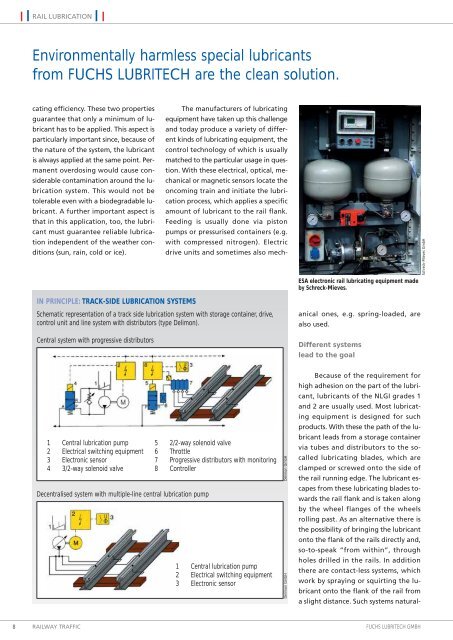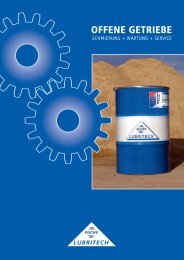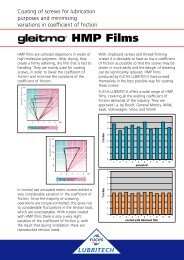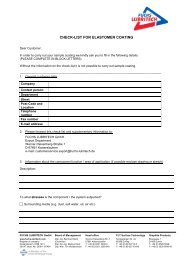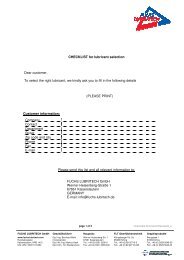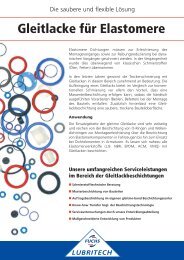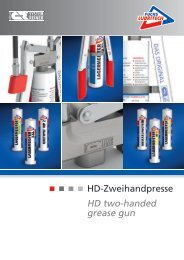LUBRICANTS FOR RAILWAY TRAFFIC - Fuchs Lubritech GmbH
LUBRICANTS FOR RAILWAY TRAFFIC - Fuchs Lubritech GmbH
LUBRICANTS FOR RAILWAY TRAFFIC - Fuchs Lubritech GmbH
You also want an ePaper? Increase the reach of your titles
YUMPU automatically turns print PDFs into web optimized ePapers that Google loves.
I I RAIL LUBRICATION I I<br />
Environmentally harmless special lubricants<br />
from FUCHS LUBRITECH are the clean solution.<br />
cating efficiency. These two properties<br />
guarantee that only a minimum of lubricant<br />
has to be applied. This aspect is<br />
particularly important since, because of<br />
the nature of the system, the lubricant<br />
is always applied at the same point. Permanent<br />
overdosing would cause considerable<br />
contamination around the lubrication<br />
system. This would not be<br />
tolerable even with a biodegradable lubricant.<br />
A further important aspect is<br />
that in this application, too, the lubricant<br />
must guarantee reliable lubrication<br />
independent of the weather conditions<br />
(sun, rain, cold or ice).<br />
IN PRINCIPLE: TRACK-SIDE LUBRICATION SYSTEMS<br />
Schematic representation of a track side lubrication system with storage container, drive,<br />
control unit and line system with distributors (type Delimon).<br />
Central system with progressive distributors<br />
1 Central lubrication pump<br />
2 Electrical switching equipment<br />
3 Electronic sensor<br />
4 3/2-way solenoid valve<br />
Decentralised system with multiple-line central lubrication pump<br />
The manufacturers of lubricating<br />
equipment have taken up this challenge<br />
and today produce a variety of different<br />
kinds of lubricating equipment, the<br />
control technology of which is usually<br />
matched to the particular usage in question.<br />
With these electrical, optical, mechanical<br />
or magnetic sensors locate the<br />
oncoming train and initiate the lubrication<br />
process, which applies a specific<br />
amount of lubricant to the rail flank.<br />
Feeding is usually done via piston<br />
pumps or pressurised containers (e.g.<br />
with compressed nitrogen). Electric<br />
drive units and sometimes also mech-<br />
5 2/2-way solenoid valve<br />
6 Throttle<br />
7 Progressive distributors with monitoring<br />
8 Controller<br />
1 Central lubrication pump<br />
2 Electrical switching equipment<br />
3 Electronic sensor<br />
ESA electronic rail lubricating equipment made<br />
by Schreck-Mieves.<br />
anical ones, e.g. spring-loaded, are<br />
also used.<br />
Different systems<br />
lead to the goal<br />
Because of the requirement for<br />
high adhesion on the part of the lubricant,<br />
lubricants of the NLGI grades 1<br />
and 2 are usually used. Most lubricating<br />
equipment is designed for such<br />
products. With these the path of the lubricant<br />
leads from a storage container<br />
via tubes and distributors to the socalled<br />
lubricating blades, which are<br />
clamped or screwed onto the side of<br />
the rail running edge. The lubricant escapes<br />
from these lubricating blades towards<br />
the rail flank and is taken along<br />
by the wheel flanges of the wheels<br />
rolling past. As an alternative there is<br />
the possibility of bringing the lubricant<br />
onto the flank of the rails directly and,<br />
so-to-speak “from within”, through<br />
holes drilled in the rails. In addition<br />
there are contact-less systems, which<br />
work by spraying or squirting the lubricant<br />
onto the flank of the rail from<br />
a slight distance. Such systems natural-<br />
8 <strong>RAILWAY</strong> <strong>TRAFFIC</strong><br />
FUCHS LUBRITECH GMBH<br />
Delimon <strong>GmbH</strong> Delimon <strong>GmbH</strong><br />
Schreck-Mieves <strong>GmbH</strong>


